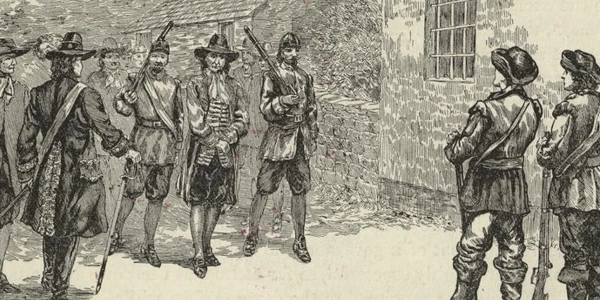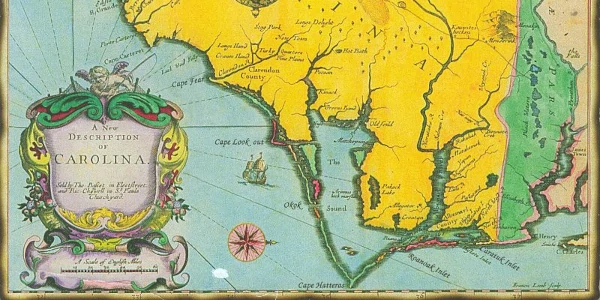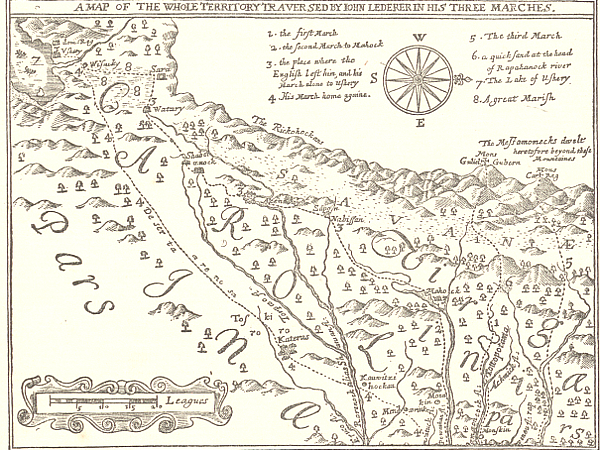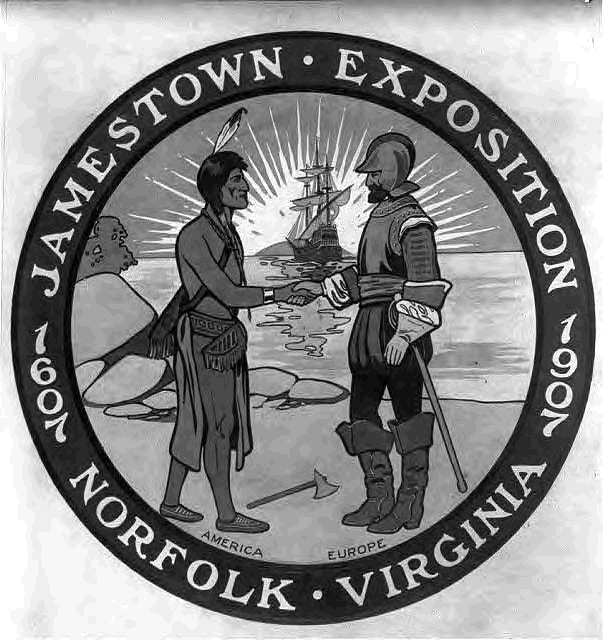Sponsor this page for your business, school, or personal needs. Your banner or text ad can fill the space above.
Click here to Sponsor the page and how to reserve your ad.
-
Timeline
1677 Detail
December 3, 1677 - North Carolina colonists engage in Culpeper's Rebellion against unfair custom duties charged due to the series of Navigation Acts passed by the English Parliament.

The Colony or Province of Carolina had been culled from parts of the original Virginia colony and chartered in 1663. Yes, Spain had originally, before the English, considered it part of the Ponce de Léon territorial splurge, but that long ago had been altered. It was, after the Spanish had departed and considered it their territory, been inhabited by the Native population. However, in 1629, King Charles I, gave a patent to his attorney-general, Sir Robert Heath, but he had done nothing with it, thus it was deemed invalid and rechartered to eight Lord Proprietors. This was Native American territory becoming English territory, with English subjects, and some of them didn't like what was going on. Predominantly, they hated the Navigation Acts, a series of control colonial commerce legislation enacted in the 1650's through 1660. The colony, unlike its New England cousins, was not based on religion, but physical and political strength.
Governing the colony since 1663 had been no easy task. Yes, a government had been formed in 1664 in Albermarle. There would be a governor, William Drummond from Virginia, deputy governor, and a unicameral assembly, which had elected representatives. However, it had not been working well. There were Virginia colonists in the area used to their colonial ways. Now there were new residents coming from the East Indies used to their manner. They disagreed on planting styles, how to govern, and how to defend themselves. Adding to this, the original agreement of 1665 was changed, with its replacement, "Fundamental Constitutions of Carolina," favoring the Lord Proprietors (who all resided in England) and a Fuedal system in 1670. The area was beset by bad weather, changes in governors to Philip Carteret, then John Jenkins as deputy governor when Carteret sailed to England for aid. He did not receive any. By 1677, the confluence of those factors and the Navigation Acts was beginning to rile a faction of Carolinians. There were five rebellions around Albermarle, which was the first populated region of the Carolinas; the colonists there had a vibrant independent streak. Yes, in this rebellion of 1677, its largest, one of the colonists was named John Culpeper, from whom the rebellion took its name. He was not the only leader, a South Carolinian with the title of surveyor general, but had a reputation for creating political trouble there. He was neither poor, nor unconnected, with ties to Governor of Virginia William Berkeley and with a plantation of three hundred and seventy acres.
Since the Navigation Acts had been enacted, their taxes had not been collected in the Carolinas, as they were struggling. However, now they would be. Not only were there going to be custom duties, but they could not import anything that did not come directly from England, there were trade restrictions with other colonies, and American goods had to be sold to English merchants. But the customs taxes were the big ticket. The Navigation Acts were going to charge a one penny per pound tax on tobacco at the port of sale. The price of tobacco during some of these years was only 2 cents per pound. It was an onerous duty, which Deputy Governor John Jenkins did not agree with, and did not attempt to collect. However, other council members, including Thomas Eastchurch, disagreed and wanted the tax collected; his faction would eventually win. John Culpeper and his cohorts could stand it no longer.
John Culpeper and the Anti-Proprietors
Culpeper had arrived in Albermarle in November 1673, and joined the faction of John Jenkins. He convinced Jenkins to arrest the leader of the proprietor's faction, Thomas Miller, who had not yet satisfied the colonists that the Indian war was over, but wanted to confiscate their guns. During a council meeting in March 1676, Jenkins had Miller charged with blasphemy and treason. He was imprisoned through May, taken in chains for trial in Virginia, although the Palatine Court was bound to acquit him, which they did. Thomas Miller did not wait long after his acquittal to leave the colony and travel back to England to meet with the Carolina Lord Proprietors. Meanwhile, political violence between the two factions continued in Albermarle. Judge John Willoughby, refused a subpoena from Thomas Eastchurch, beating the summons officer. Thomas Cullen, antiproprietory supporters, was banned from the assembly for trading with the Natives. Jenkins still had control of the governorship, despite the unrest, in the fall of 1676. At the same time, Eastchurch, now joining Miller in England, got complete control of the governorship of the county by decree of the Lord Proprietors. Yes, a battle was about to begin.
Miller had been appointed Eastchurch's secretary and customs collector. As they sailed back to the Carolinas in the summer of 1677, however, Thomas Eastbrook fell in love with an heiress in the East Indies, Nevis, married her, and decided to stay. He appointed Miller temporary governor and sent him back to Albermarle County (today's Pasquotank County) to enforce the new arrangement. Immediately upon Thomas Miller's return, he was assaulted by antiproprietor member Patrick White. Miller continued his customs plan none-the-less, hiring a new tax collector and a new militia to back him.
On December 1, 1677, George Durant, another antiproprietor, returned from England and was arrested by Governor Miller. Two days later, despite being in New England and absent from Albermarle for several months, John Culpeper raided Timothy Biggs' home and confiscated the county records. He wrote "Remonstrance" a plea for county residents to revolt. He arrested Governor Miller, and sent aides to other counties to arrest their leaders. In Albermarle, the revolt now had a mob. By the end of December, the antiproprietors from Albermarle, Currituck, and Chowan had birthed a new assembly of eighteen and began to run the colony. Some sources state that John Culpeper was chosen Governor, although others say that was incorrect, that he was only appointed customs collector; others state that John Jenkins took back his position as head of council. Their only opponent, on his honeymoon in the East Indies, Thomas Eastchurch, had died. A comedy would state that the heiress was too much for him.
It was almost nine months before an escaped enemy to the new government, Thomas Biggs, sailed to London and told the Lord Proprietors that they were in jeopardy of losing their colony. He was swiftly appointed customs officer, and he, and a Lord Proprietor Seth Shotel as Governor, were sent back to gain control. Despite unfortunate matters (Sothel was captured by Turkish pirates), another appointed Governor John Harvey, who had gained respect from both sides of the rebellion, regained control of the assembly and went about his duties.
John Culpeper was arrested and sent back to London. Brought to trial, he somehow convinced the Lord Proprietors that a fine of five hundred pounds, self-imposed as he admitted to the rebellion, was sufficent for his release. He was arrested again upon Miller's request in December 1679; this trial ended as the first, with his acquittal, this time with the Lord Proprietors on his side. They had not wanted to admit to the King that they could not control their own colony.
Buy Chronology

Remonstrance
Remonstrance from the inhabitants of the Pasquotank area concerning their grievances against Thomas Miller
Culpeper, John; Et Al.
December 03, 1677.
First the occasion of their secureinge the Records & imprisoning the Presidt is, that thereby the Countrey may have a free parlemt & that from them their aggreivances may be sent home to the Lords, wch are breifely these; In the first place (omitting many hainous matters) hee denied a free election of an Assembly and hath positively cheated the Countrey of one hundred and thirty thousand pounds of Tobacco which hath raised the levie to two hundred and fifty pounds of Tobo per head more then otherwaies it would have beene besides neer twenty thousand pounds of Tobo charge he hath brought upon us by his pipeing guard & now Capt. Gillam is come amongst us with three times the goods hee brought last yeare but had not beene two houers on shore, but for the slip of a word was arrested for one thousand pounds sterling & many affronts and indignities thrown upon him by ye Presidt himselfe, in somuch that had hee not beene earnestly perswaded by some hee had gone directly out of the Countrey and the same night (about midnight) hee went aboard with a brace of pistolls and presenting one of them cockt to Mr Geo. Durants breast & wth his other hand arrested him as a Traytour and many other Injuries, mischiefes and grievances hee hath brought upon us, that thereby an inevitable ruein is comeing (unlesse prevented) which wee are now about to doe and hope & expect that you will joyne with us therein, and subscribe this 3d day of 10ber 1677.
Willm Crafford, Willm Bird, Edwd Wells, Jno Halford And 30 more wch for brevitie I omitt to insert
Source: Drawing of the arrest of Thomas Miller during Culpeper's Rebellion, date unknown. Courtesy New York Public Library Digital Collections. Image below: Map of the Carolinas, 1676, John Stean. Courtesy Wikipedia Commons. Info source: Library of Congress; "Culpeper's Rebellion, 1677-1678, the Second Rebellion in 17th Century Colonial America," Randal Rust, americanhistorycentral.com; "Culpeper's Rebellion, 1979, Mattie Parker, NCpedia; "Culpeper's Rebellion," North Carolina History Project, northcarolinahistory.org; "Culpeper's Rebellion," culpepperconnections.com; "The Remonstrance of the Inhabitants of Pasquotank," docsouthunc.edu; Wikipedia.

History Photo Bomb

Governing the colony since 1663 had been no easy task. Yes, a government had been formed in 1664 in Albermarle. There would be a governor, William Drummond from Virginia, deputy governor, and a unicameral assembly, which had elected representatives. However, it had not been working well. There were Virginia colonists in the area used to their colonial ways. Now there were new residents coming from the East Indies used to their manner. They disagreed on planting styles, how to govern, and how to defend themselves. Adding to this, the original agreement of 1665 was changed, with its replacement, "Fundamental Constitutions of Carolina," favoring the Lord Proprietors (who all resided in England) and a Fuedal system in 1670. The area was beset by bad weather, changes in governors to Philip Carteret, then John Jenkins as deputy governor when Carteret sailed to England for aid. He did not receive any. By 1677, the confluence of those factors and the Navigation Acts was beginning to rile a faction of Carolinians. There were five rebellions around Albermarle, which was the first populated region of the Carolinas; the colonists there had a vibrant independent streak. Yes, in this rebellion of 1677, its largest, one of the colonists was named John Culpeper, from whom the rebellion took its name. He was not the only leader, a South Carolinian with the title of surveyor general, but had a reputation for creating political trouble there. He was neither poor, nor unconnected, with ties to Governor of Virginia William Berkeley and with a plantation of three hundred and seventy acres.
Since the Navigation Acts had been enacted, their taxes had not been collected in the Carolinas, as they were struggling. However, now they would be. Not only were there going to be custom duties, but they could not import anything that did not come directly from England, there were trade restrictions with other colonies, and American goods had to be sold to English merchants. But the customs taxes were the big ticket. The Navigation Acts were going to charge a one penny per pound tax on tobacco at the port of sale. The price of tobacco during some of these years was only 2 cents per pound. It was an onerous duty, which Deputy Governor John Jenkins did not agree with, and did not attempt to collect. However, other council members, including Thomas Eastchurch, disagreed and wanted the tax collected; his faction would eventually win. John Culpeper and his cohorts could stand it no longer.
Miller had been appointed Eastchurch's secretary and customs collector. As they sailed back to the Carolinas in the summer of 1677, however, Thomas Eastbrook fell in love with an heiress in the East Indies, Nevis, married her, and decided to stay. He appointed Miller temporary governor and sent him back to Albermarle County (today's Pasquotank County) to enforce the new arrangement. Immediately upon Thomas Miller's return, he was assaulted by antiproprietor member Patrick White. Miller continued his customs plan none-the-less, hiring a new tax collector and a new militia to back him.
On December 1, 1677, George Durant, another antiproprietor, returned from England and was arrested by Governor Miller. Two days later, despite being in New England and absent from Albermarle for several months, John Culpeper raided Timothy Biggs' home and confiscated the county records. He wrote "Remonstrance" a plea for county residents to revolt. He arrested Governor Miller, and sent aides to other counties to arrest their leaders. In Albermarle, the revolt now had a mob. By the end of December, the antiproprietors from Albermarle, Currituck, and Chowan had birthed a new assembly of eighteen and began to run the colony. Some sources state that John Culpeper was chosen Governor, although others say that was incorrect, that he was only appointed customs collector; others state that John Jenkins took back his position as head of council. Their only opponent, on his honeymoon in the East Indies, Thomas Eastchurch, had died. A comedy would state that the heiress was too much for him.
It was almost nine months before an escaped enemy to the new government, Thomas Biggs, sailed to London and told the Lord Proprietors that they were in jeopardy of losing their colony. He was swiftly appointed customs officer, and he, and a Lord Proprietor Seth Shotel as Governor, were sent back to gain control. Despite unfortunate matters (Sothel was captured by Turkish pirates), another appointed Governor John Harvey, who had gained respect from both sides of the rebellion, regained control of the assembly and went about his duties.
John Culpeper was arrested and sent back to London. Brought to trial, he somehow convinced the Lord Proprietors that a fine of five hundred pounds, self-imposed as he admitted to the rebellion, was sufficent for his release. He was arrested again upon Miller's request in December 1679; this trial ended as the first, with his acquittal, this time with the Lord Proprietors on his side. They had not wanted to admit to the King that they could not control their own colony.
Buy Chronology

Culpeper, John; Et Al. December 03, 1677.
First the occasion of their secureinge the Records & imprisoning the Presidt is, that thereby the Countrey may have a free parlemt & that from them their aggreivances may be sent home to the Lords, wch are breifely these; In the first place (omitting many hainous matters) hee denied a free election of an Assembly and hath positively cheated the Countrey of one hundred and thirty thousand pounds of Tobacco which hath raised the levie to two hundred and fifty pounds of Tobo per head more then otherwaies it would have beene besides neer twenty thousand pounds of Tobo charge he hath brought upon us by his pipeing guard & now Capt. Gillam is come amongst us with three times the goods hee brought last yeare but had not beene two houers on shore, but for the slip of a word was arrested for one thousand pounds sterling & many affronts and indignities thrown upon him by ye Presidt himselfe, in somuch that had hee not beene earnestly perswaded by some hee had gone directly out of the Countrey and the same night (about midnight) hee went aboard with a brace of pistolls and presenting one of them cockt to Mr Geo. Durants breast & wth his other hand arrested him as a Traytour and many other Injuries, mischiefes and grievances hee hath brought upon us, that thereby an inevitable ruein is comeing (unlesse prevented) which wee are now about to doe and hope & expect that you will joyne with us therein, and subscribe this 3d day of 10ber 1677.
Willm Crafford, Willm Bird, Edwd Wells, Jno Halford And 30 more wch for brevitie I omitt to insert
Source: Drawing of the arrest of Thomas Miller during Culpeper's Rebellion, date unknown. Courtesy New York Public Library Digital Collections. Image below: Map of the Carolinas, 1676, John Stean. Courtesy Wikipedia Commons. Info source: Library of Congress; "Culpeper's Rebellion, 1677-1678, the Second Rebellion in 17th Century Colonial America," Randal Rust, americanhistorycentral.com; "Culpeper's Rebellion, 1979, Mattie Parker, NCpedia; "Culpeper's Rebellion," North Carolina History Project, northcarolinahistory.org; "Culpeper's Rebellion," culpepperconnections.com; "The Remonstrance of the Inhabitants of Pasquotank," docsouthunc.edu; Wikipedia.






